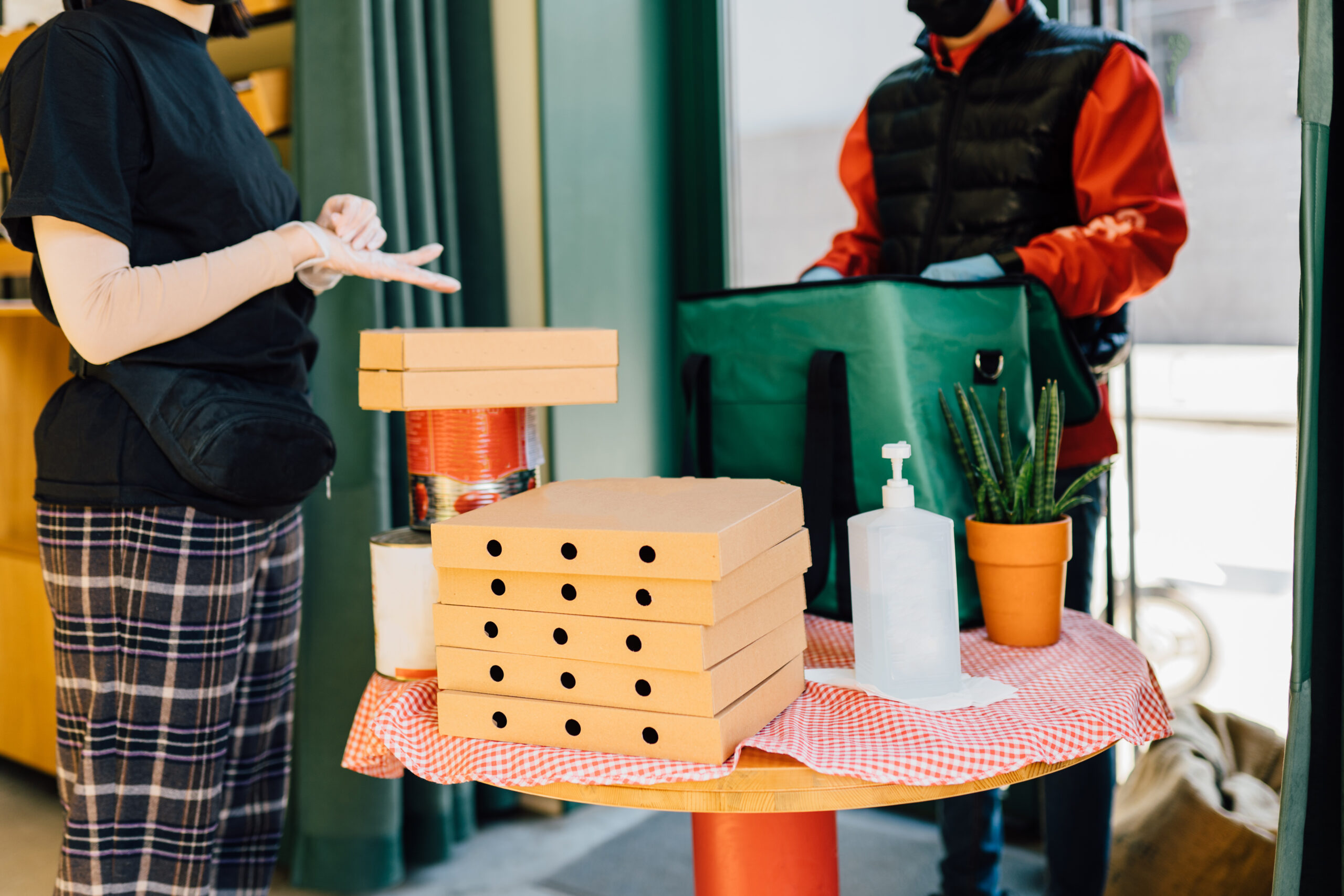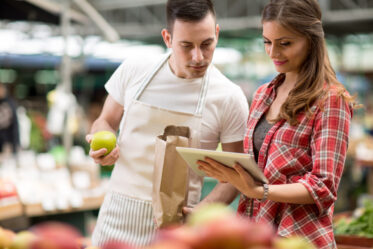
Though the Covid-19 pandemic dealt the food and beverage industry heavy blows, it also stimulated creativity to keep doors open. These changes, though often drastic, have persisted to stimulate the industry and generate new trends powerful enough to affect food and beverage sales.
The rise of more “ghost kitchens”
One such trend has been the emergence of ghost kitchens, also known as “dark kitchens” or “cloud kitchens.” In response to the Covid-19 pandemic closing in-person dining, restaurants prioritized pick-up and delivery.
Some restaurants did this by operating from established kitchens and delivering meals using existing wait staff, or online delivery services such as Grubhub, DoorDash, and Uber. While this kept local food and beverages establishments alive, it also stimulated other business models.
For example, some restaurants combined resources and produced meals in an off-site ghost kitchen. Some food and beverages franchises even tested new products through ghost kitchens under different company names. These new concepts allowed franchises to diversify their menus, business portfolios, and market outreach and viability.
A ghost kitchen is a low-risk model with very low overhead and limited personnel. In 2020, the Restaurant Industry & Market Evolution reported 52% of surveyed restaurants were considering setting up a ghost kitchen, or some sort of delivery-only service.
When combined with a brick-and-mortar in-person dining room, this becomes a perfect hybrid business model for food and beverage sales. This can be a wise move, considering 64% of consumers aren’t planning to return to their pre-Covid habits of dining in restaurants. Weekly takeout and delivery have become 61% of consumer orders, a staggering uptick from 29% one year ago.
Greater demand for functional foods
During the Covid-19 pandemic, consumers developed an expectation for instant delivery of goods and services to satiate their quarantine cravings. It’s not easy to subdue the mounting desire for cookie dough when you haven’t spent much time outside in months. However, as pandemic restrictions eased, people began to realize they were paying a physical price around their waistlines for their cravings – dubbed the “Quarantine 15”. Upon realizing the connection between the food we consume, our body, and its immunity, people began to seek functional foods – also known as nutraceuticals – for their health benefits.
Originating in Japan during the 1980s, these conventional and modified functional foods provide vital nutrients. Conventional foods are natural foods rich in vitamins, minerals, healthy fats, and antioxidants – such as vegetables, fruits, nuts, seeds, whole grains, lean meats, and seafood. Modified foods have added vitamins, minerals, fiber, or probiotics.
Fortified milk and bread are common modified foods. These foods prevent nutrient deficiencies, protect against diseases (like heart or thyroid disease), and promote proper infant and child development.
In 2020, 80% of consumers worldwide indicated they planned to eat and drink more healthily in 2021 as a direct result of COVID-19. In addition, 33% of consumers seek out food and beverage products to meet their health needs. This dedication to health has undoubtedly affected food and beverage sales. In North America alone, the functional food and beverage market is expected to grow by $32.58 billion from 2022 to 2026, progressing at a CAGR of 7.29%.
Increased demands for plant-based products
One of the growing trends in functional foods within food and beverage sales is plant-based products. The demand for these functional foods isn’t solely based on personal health reasons, but also a global concern for climate change and sustainable production.
2020 Nielsen data reported meat alternative sales were up 129% from pre-Covid levels in early 2019, making it one of the five categories with the greatest sales throughout the pandemic. Though some of the increased plant-based sales may have been a result of rising meat prices, sustainability was also a factor.
A 2021 Hartman Group study for the Food Marketing Institute (FMI) found that 29% of consumers are choosing less meat, with 9% of them going totally meatless. In the US alone, more than half of all consumers are choosing plant-based foods. That is hundreds of millions of people, in the US alone. Needless to say, the demand for alternative plant-based meat and cultured meat products is skyrocketing.
As the effects of global warming have become glaringly apparent, consciousness about sustainable production has seen an annual 24% increase. Habitat conservation, regenerative farming, and carbon footprint reduction are becoming huge factors in consumer decision-making.
We know that greenhouse gas emissions are the greatest threat to Earth and the future of humanity. What may be lesser known is the fact that global food production comprises nearly 35% of these greenhouse gas emissions. Additionally, animal-based food production requires about 70% more land than farming, and also claims a larger portion of greenhouse gas production.
As consumers become more aware of the impact of their food choices, they are changing their habits. This has resulted in a 300% increase in the use of plant-based foods in the U.S. over the past 15 years—an upward trend with potential global sales of $162 billion by 2030.
Food and beverages dominating ecommerce
Food and beverages sales have always been part of the ecommerce market. However, increased exposure to online models during the pandemic is moving food and beverage marketing away from mass promotions toward targeted digital areas.
A McKinsey & Company survey recently showed that 76% of consumers tried a new brand/new way of shopping during the pandemic, and 66% of them will remain loyal to these new companies. Shifts in ecommerce for the food and beverage industry include moving toward sustainability, working with local suppliers/vendors, syncing brands with personal values, creating ease in online ordering, and emphasizing direct-to-consumer distribution.
Knowing who your target consumers are and what products they are ordering is vital to increasing food and beverage sales. Therefore, it’s essential to have an online sales portal that is linked internally with suppliers.
The food and beverage industry makes over 428 business purchases every day, usually through vendors’ websites. Incorporating an enterprise resource planning (ERP) system into your food and beverage business can help meet new demands, by integrating it with an ecommerce system that can track inventory and manage food and beverage information.
Integrated web stores, via a website or an app, can also increase food and beverage sales and expedite data synchronization. Online sales are predicted to comprise 15-20% of all food and beverage sales by 2025.
Technology will remain a central player across the industry
Though the food and beverage industry has historically been slower to incorporate technology, it’s now finding online tools/platforms that can be integrated into sales and day-to-day business practices.
The integration of digital apps and devices will only accelerate. This successful integration will improve productivity and workflow while reducing delivery hurdles. The Covid-19 pandemic forced many industry providers to operate with greater efficiency despite having fewer personnel. This demand prompted more automation from technology, including drone deliveries, robotics in packaging, and product-picking robots at fulfillment centers.
Technology will continue to impact food and beverage sales as consumers rely on apps far beyond the pandemic. Technology is now being used in supermarkets to track real-time sales data. This allows stores to learn who is shopping, as well as where, when, and what products they are buying. This can impact inventory and result in more appropriately stocked shelves. Restaurants can use similar data analytics to understand consumer choices and patterns of ordering. They can also use technology to increase efficiency, through electronic menus and tablet ordering.
This accelerated digitization stimulated the use of online ordering systems that offer a wider range of products – such as customized meal kits. Restaurants’ ecommerce infrastructure completely changed to ensure customer loyalty and boost food and beverage sales.
Traditional sales techniques are out, “new recipes” are in
Customers are more educated and tech-savvy – with more options at their fingertips – than ever before. Old sales techniques no longer apply, but you still need to meet them on an equal footing when trying to close sales. Traditional sales once involved pounding the pavement, knocking on doors, making cold phone calls, and attending trade shows. Once potential customers were found, phone calls, emails, or meetings were set up in sequence. Modern sales techniques differ, as they use digital and social selling to find and engage new customers through buyer-centric messaging.
Food and beverage sales are often very subjective and personal. Using technology that tracks consumers’ interests is especially important if your food and beverage company has more than one location. Knowing what your customers want can help promote related items or lay the ground for piquing new interest.
Work with the right tool for your business
Increasing food and beverage sales depends on truly understanding both your existing customers and new consumer trends. Technology is the key to doing both. By partnering with a proven technology expert such as Skynamo, you can integrate sales with your ERP, track your sales reps, coordinate with suppliers and vendors, manage everything through a central dashboard, and ensure that your data stays secure.
If you’re interested in leveling up your business to meet the needs of today’s consumers, consider chatting with a Skynamo representative today!


